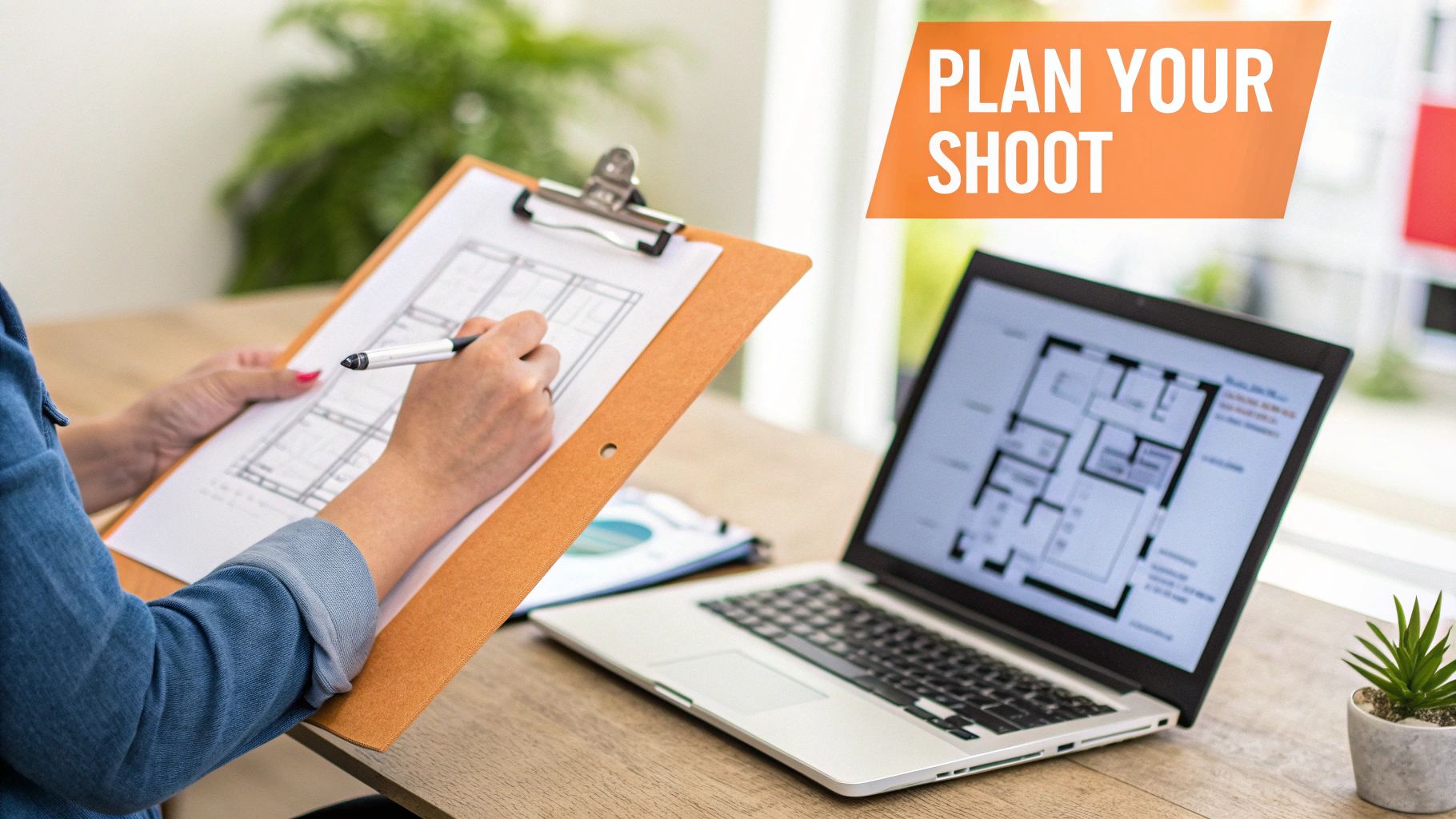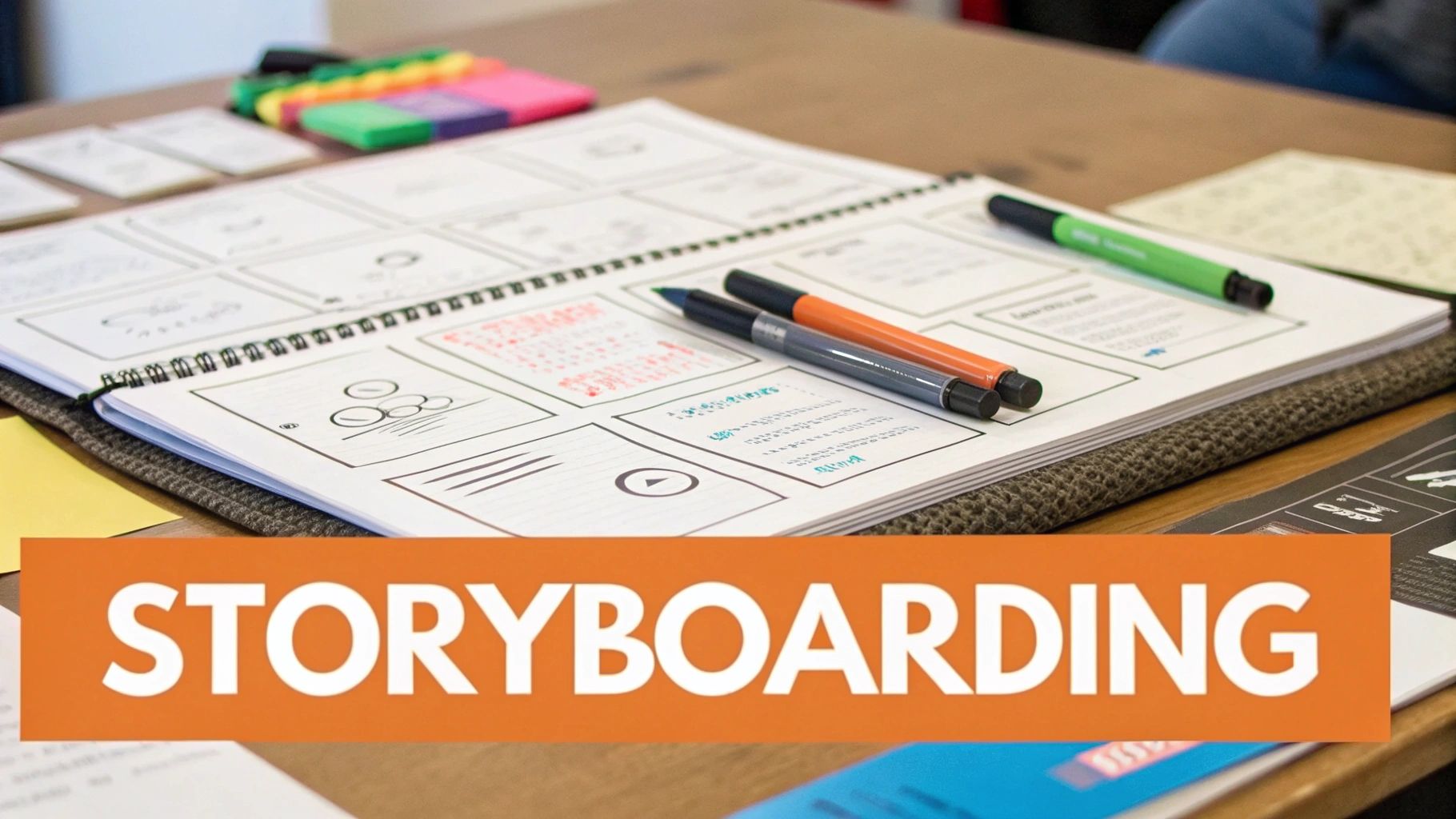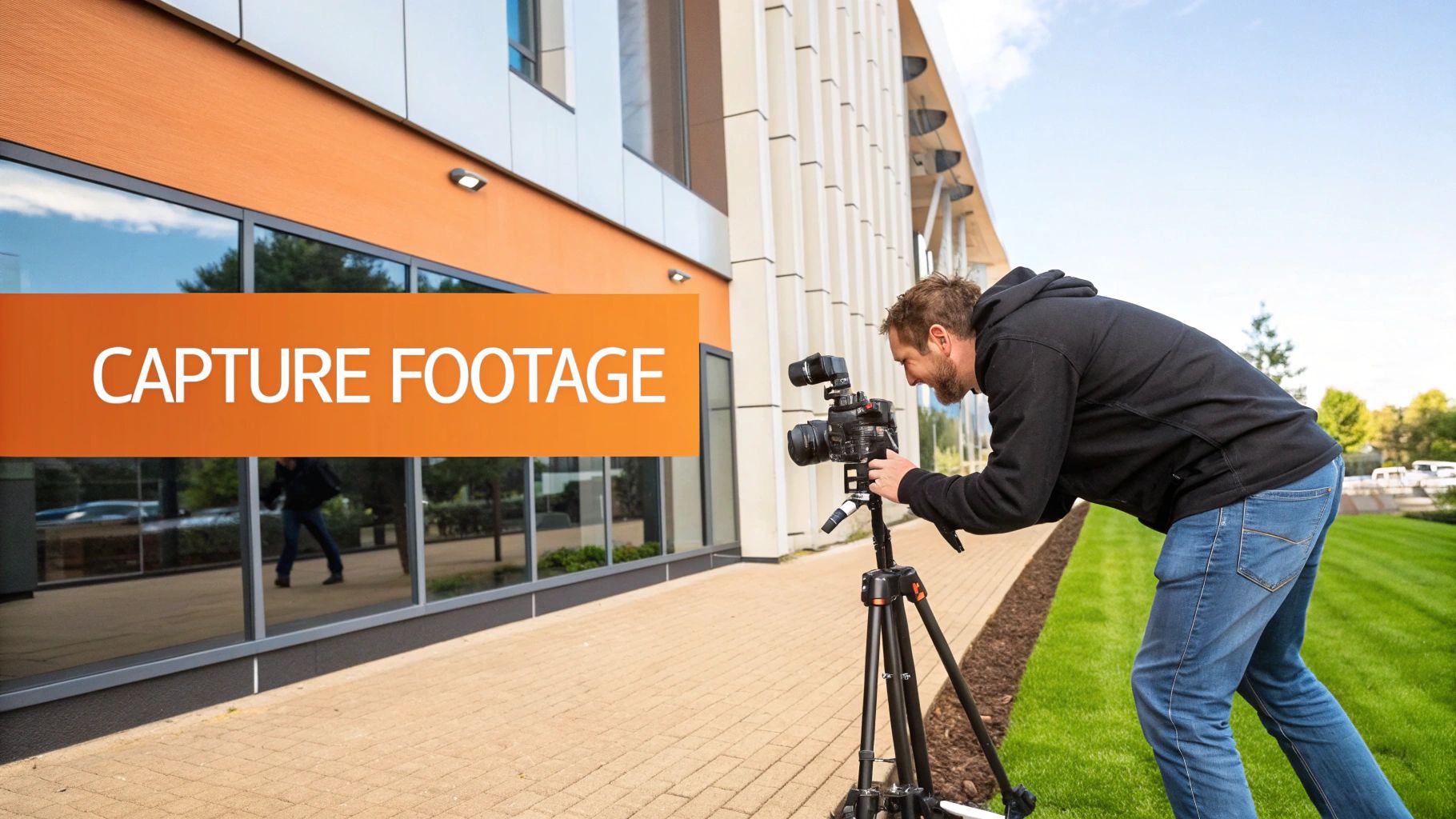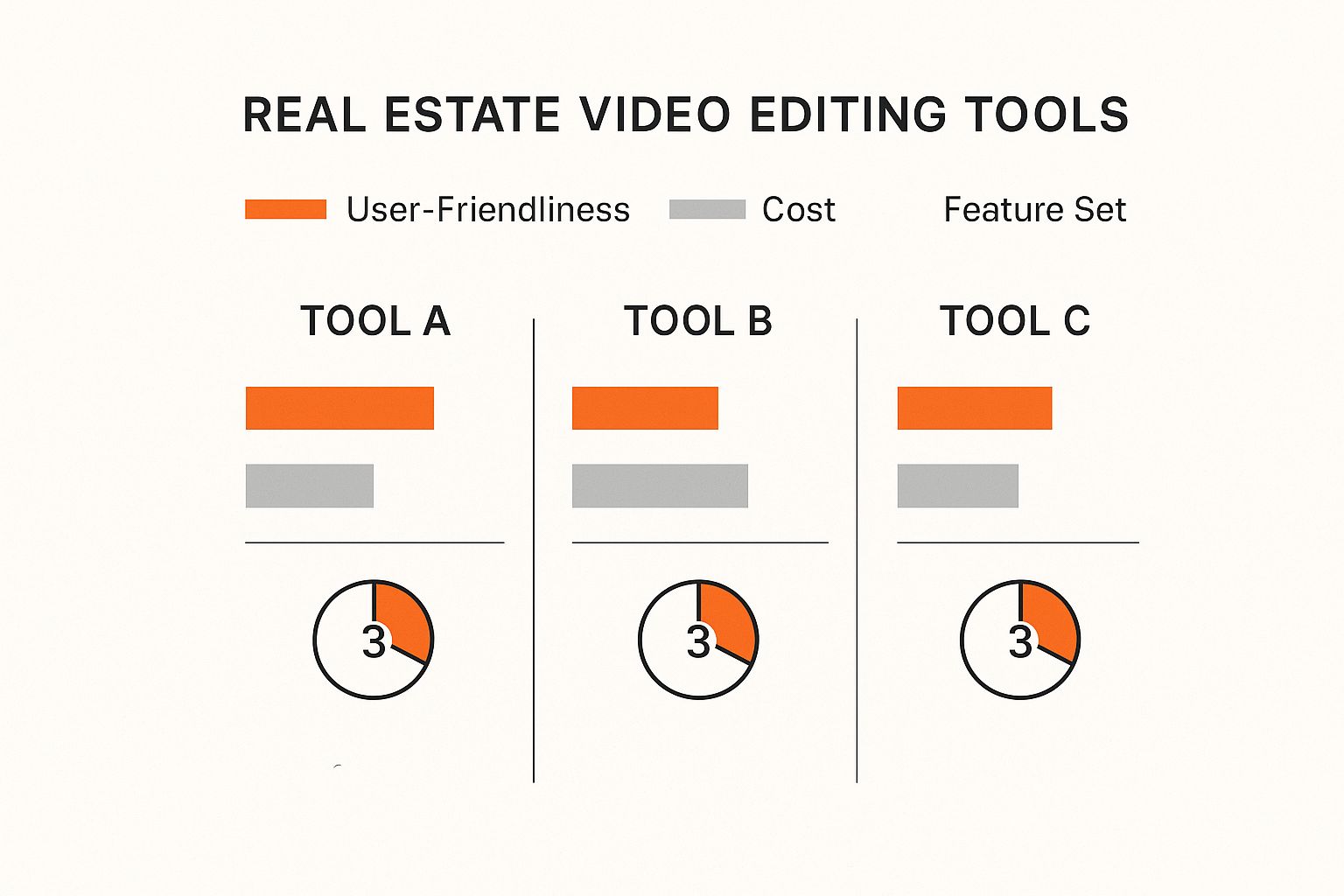How to Make Real Estate Videos That Sell Fast
Learn how to make real estate videos that attract buyers and close deals quickly. Discover expert tips for shooting, editing, and marketing your listings.
If you want your listings to stand out, you have to move beyond static photos. The real magic happens when you use video to tell a story—one that builds an emotional bridge between a buyer and a property. It’s about combining smooth camera work with a narrative that truly shows off a home's best features, helping buyers imagine their life there.
Why Video Is a Must-Have for Modern Real Estate
In a packed marketplace, just posting photos of a property won’t cut it anymore. Today’s buyers expect a richer experience; they want to feel what it's like to be in a home before they even consider a visit. This is where video becomes your secret weapon, turning a flat listing into an exciting tour that grabs attention from the first second.

Driving Serious Engagement and Closing Deals Faster
Video completely changes the game. Instead of just swiping through a gallery, potential buyers are taken on a guided walkthrough. They're not just looking; they're participating. This immersive format helps them understand the home's layout, get a feel for the flow between rooms, and soak in the property's unique atmosphere.
The numbers don't lie. Take a look at how video content directly impacts listing performance.
The Impact of Video on Real Estate Listings
| Metric | Performance Boost with Video |
|---|---|
| Buyer Inquiries | 403% more inquiries on listings with video. |
| Sale Speed | Properties sell up to 31% faster when marketed with video. |
| Lead Quality | Videos attract more serious, pre-qualified buyers. |
| Agent Branding | Establishes you as a modern, trustworthy agent. |
As the data shows, the impact is undeniable. In 2025, listings with videos are projected to get a staggering 403% more inquiries than those without. On top of that, homes marketed with video tend to sell up to 31% faster. It’s clear that a good video tour can significantly speed up the journey from "just looking" to "making an offer."
A great video doesn't just show a house; it sells a lifestyle. It’s the difference between telling someone a home is beautiful and letting them feel it for themselves.
Building Trust and Attracting Better Leads
A well-made video also does wonders for your personal brand. When you guide viewers through a home, you’re not just a salesperson; you become a trusted expert. It's a personal touch that photos alone just can't match, building a genuine connection with your audience.
Video also works as a fantastic lead filter. A detailed walkthrough gives a serious buyer all the information they need to decide if the property is a real contender. This means the calls and emails you get are far more likely to come from people who are genuinely interested, saving you time and letting you focus on the most promising prospects.
You can learn more about how to structure these presentations in our complete guide to virtual tours for realtors. And for an even deeper look at how aerial shots can elevate your marketing, this real estate drone photography guide covers everything from photography to video.
Weaving a Story into Your Property Video
Long before you hit record, the best real estate videos are already coming to life. It's a common mistake to think a property video is just about walking through rooms. The real magic happens when you build a story that makes a potential buyer feel an instant connection to the home. This initial planning is what separates a forgettable tour from a compelling narrative that sells a lifestyle.
First things first, what's the point of this video? Are you aiming for a detailed, room-by-room virtual tour that lets viewers inspect every corner and understand the layout? Or is this more of a lifestyle piece, meant to showcase the neighborhood, nearby coffee shops, and what it feels like to live there? Knowing your goal from the start dictates every decision you'll make, from the shots you take to the music you choose.
Plan Your Visuals
With a clear goal in mind, it's time to create a shot list. This doesn't have to be a big production. A simple checklist on your phone or in a notebook works perfectly. Walk through the home mentally, putting yourself in a buyer's shoes. What's the first thing they should see? What's the most logical and appealing path through the house?
A solid shot list is your roadmap. It ensures you capture all the money shots and don't get back to your computer only to realize you forgot the primary bathroom. For example, your list might look something like this:
- Morning Light: Capture the sun pouring into the kitchen.
- The Big Reveal: A slow pan from the front door into the main living area.
- Character Details: Tight shots of the cozy fireplace, built-in bookshelves, or unique tilework.
- Outdoor Living: A sweeping shot of the backyard or a peaceful view from the balcony.
Having this plan before you make real estate videos is a huge time-saver on shoot day and guarantees you have everything you need for a smooth edit.
Tell a Story That Truly Connects
Okay, you have your list. Now, think about the why behind each shot. Don't just show features; sell the benefits. That big backyard isn't just grass; it’s the future host of summer barbecues and kids' birthday parties. The updated kitchen isn't just about new appliances; it’s where a family will gather for pancakes on a Saturday morning.
A great property video helps buyers picture their own lives unfolding in that space. Your job is to stir emotion, not just document square footage. Let your camera tell the story of what their new life could look like.
For example, if there’s a bonus room, don't just show an empty space. Frame it as the perfect quiet home office, a fun playroom, or a private yoga studio. Your video needs to answer the questions buyers haven't even thought to ask yet. By weaving these relatable mini-stories into your footage, you create an impression that’s far more powerful and memorable than any photo ever could be.
Getting Professional Shots on a Real-World Budget
You don't need a Hollywood-sized budget to make your real estate videos look sharp and professional. It’s all about knowing where to put your money for the biggest impact. And here’s the good news: you probably already have the most important piece of equipment in your pocket.

That's right, your smartphone. Modern phone cameras are incredible, shooting high-resolution video that’s more than good enough for a stunning property tour. The real secret is backing up your phone with a few inexpensive accessories that fix the most common rookie mistakes, like shaky footage and bad audio.
Your Budget-Friendly Video Toolkit
Forget about dropping thousands on a complex camera rig. Just focus on these three affordable items to instantly level up your video quality. Each one solves a specific problem that can make a video feel amateurish.
- A Gimbal: This is the single best investment you can make. A gimbal is a handheld stabilizer that keeps your phone level and your movements silky smooth. It’s a game-changer for getting those fluid, cinematic shots as you walk through a property. No more jitters.
- A Clip-On Wide-Angle Lens: Ever notice how phone cameras can make rooms feel small and cramped? A simple clip-on wide-angle lens fixes that, instantly making spaces feel more open, airy, and inviting.
- A Lavalier Microphone: You can have the most beautiful video in the world, but poor audio will kill it. An inexpensive "lav" mic that clips onto your shirt and plugs into your phone ensures your voice is crystal clear, even with background noise.
A lot of what makes a great photo also applies to video. For a deeper dive into framing, composition, and lighting, check out these essential real estate photography tips. The principles will absolutely help you frame better video shots.
Mastering Light and Audio
Great video really comes down to two things: light and sound. Before you even think about buying a lighting kit, learn to work with what the property gives you. Natural light is your best friend.
Always try to film during the day. Throw open all the blinds and curtains to flood the space with as much light as possible. This creates that bright, welcoming feel that makes any home more appealing. If a room is still a bit dim, a single, affordable LED light panel can make a huge difference by filling in dark corners and shadows.
Buyers will forgive a lot, but they won't forgive shaky video and muffled audio. If you only focus on two things, make them smooth motion and clear sound. These have the biggest impact on how professional your video feels.
By focusing on these practical and affordable tools, you can easily produce polished, high-quality content. You'll be able to make real estate videos that truly showcase your listings, attract serious buyers, and help you stand out—all without draining your marketing budget.
Filming Techniques to Showcase Any Property
This is where all that careful planning pays off. Fantastic footage isn't about having the most expensive camera rig; it’s about smart, intentional camera work that tells a story and makes a property feel like a must-see. We’re moving beyond stale, static photos. The goal is to create a dynamic experience that pulls a buyer right into the home.

The secret is using slow, controlled camera movements. Think of a gentle push-in toward a window with a gorgeous view, a slow pan across a spacious living room, or a subtle tilt up to highlight a vaulted ceiling. These simple moves make your video feel polished and professional.
Why? Because they mimic how our eyes naturally explore a new space, making the tour feel more authentic. Just remember, smoothness is everything. Any jerky, sudden movements will immediately pull the viewer out of the experience.
A Room-by-Room Filming Playbook
Every room tells a story, and your camera is the narrator. Don't just stand in a corner and hit record. Think like a storyteller. What’s the hero feature of this room? Build your shots around that.
- Kitchens: This is often the main event. I always start with a wide shot from the doorway to show the scale and layout. From there, I move in for tighter shots on the money-makers: gleaming quartz countertops, brand-new appliances, or a deep farmhouse sink. A slow pan across the island is a timeless shot that always works.
- Living Areas: Your job here is to sell comfort and connection. A great trick I use is to shoot from a slightly lower angle. It makes the room feel larger and a bit more grand. If there’s a fireplace, that’s your star—make it the focal point.
- Bedrooms: These spaces need to feel like a retreat from the world. Use soft, steady movements to create a sense of calm. A slow push-in toward the main bed or a gentle pan from the window to the walk-in closet helps a buyer imagine waking up there.
When you start thinking this way, you’ll make real estate videos that do more than just show a house—they sell a lifestyle.
Shoot in a Logical Sequence
Your video needs to feel like a real-life showing, which means you need to film in an order that makes sense. Think about how you’d walk someone through the property in person. You'd start at the front door, flow into the main living areas, head to the kitchen, then check out the bedrooms and bathrooms before finishing with the backyard.
Your video's flow should mimic a real-life walkthrough. This logical progression helps viewers mentally map out the home's layout, making them feel more connected and informed as if they were exploring it in person.
Avoid jumping from the entryway to an upstairs bedroom and then back down to the kitchen. It’s confusing and completely shatters the illusion you're working so hard to build. A smooth, sequential path is the key to helping buyers feel at home long before they book a viewing. It’s this hands-on, thoughtful approach that takes your footage from good to unforgettable.
Let AI Handle the Heavy Lifting in Your Video Editing
The editing room is where the magic really happens. It’s where you take all that raw footage and transform it into a compelling story that sells a home. In the past, this was a huge time suck, often requiring complex software and a lot of patience. But thankfully, AI-powered tools have completely changed the game, making professional-quality editing accessible to everyone.
Now, you don't need to be a video wizard to get great results. These new tools are designed to do the tedious work for you. That means you can spend less time on technical fixes and more time on the creative stuff—like finding the perfect background track or nailing the pacing to keep viewers hooked.

As you can see, you don’t have to choose between powerful features and tools that are actually easy to use. The sweet spot is bigger than ever.
Automatically Enhance Your Listings
One of the biggest breakthroughs AI offers is virtual staging. Let’s face it, an empty room feels sterile and makes it tough for potential buyers to picture their own lives there. Tools like Pedra can take your video of an empty space and instantly fill it with stylish, modern furniture that fits the home's vibe perfectly.
The results speak for themselves. Virtual staging can help properties sell up to 75% faster, and an incredible 83% of virtually staged homes sell for the asking price or more. Plus, it's about 97% cheaper than hauling in physical furniture. That's an incredible return on a small investment.
To give you a better idea of what's out there, here's a quick look at some AI features that are making a real difference in real estate video production.
AI Tool Comparison for Real Estate Video Enhancement
| AI Feature | Benefit for Real Estate Videos | Example Tool |
|---|---|---|
| Virtual Staging | Fills empty rooms with stylish, realistic furniture to help buyers visualize the space. | Pedra |
| Smart Trimming | Automatically identifies and removes awkward pauses or shaky camera movements. | Descript |
| AI Voiceover | Generates a natural-sounding narration from a script, saving time on recording. | Murf.AI |
| Auto Captions | Creates and adds subtitles to your video, improving accessibility and engagement. | CapCut |
These tools aren't just about saving time; they're about producing a better final product that connects with buyers on an emotional level.
AI isn’t just a shortcut. It’s a tool that opens up creative possibilities that used to be way too expensive or time-consuming for the average agent.
From Raw Clips to a Polished Final Cut
After your property is virtually staged, AI can keep refining your video. Here’s where these tools really shine:
- Smart Trimming: The software can automatically flag and snip out any shaky footage or dead air, keeping your video snappy and professional.
- Seamless Transitions: Instead of jarring jump cuts, AI can create smooth, flowing transitions that guide the viewer naturally from one room to the next.
- Automated Video Descriptions: Some platforms can even analyze your video and write SEO-friendly titles and descriptions to help your listing get found on YouTube and Google.
By letting AI handle these technical tasks, you can focus on what matters: creating engaging videos that get people excited about a property. To dive deeper into building a full promotional plan, check out our complete guide on https://pedra.so/blog/real-estate-video-marketing.
And if you want to take your marketing automation a step further, consider using AI social media content generators for real estate. These tools can create captions and posts to promote your new videos, creating a smooth and efficient system for getting your listings seen.
Got Questions About Making Real Estate Videos? Let's Clear Things Up.
Diving into video for the first time? It’s completely normal to feel a bit overwhelmed. I’ve seen countless agents put it off, not because they don't see the power of video, but because the "how" feels like a huge obstacle. Let's walk through some of the most common questions and give you the confidence to finally hit that record button.
"How Long Should My Video Be?"
This is probably the number one question I get. You're looking for the sweet spot: between 2 and 3 minutes. That’s enough time to showcase a home’s best features without losing your viewer's attention. Go any shorter, and it might feel like you're rushing the tour. Any longer, and you risk people clicking away before they even see the master suite.
"Do I Really Have to Be on Camera?"
No, you don't have to, but I highly recommend it. Showing your face, even for a few seconds, builds an instant connection. Think of it this way: you’re not just selling a house; you’re selling your expertise and trustworthiness. A simple intro at the front door or a quick wrap-up in the backyard can make you the memorable, go-to agent.
"What About Music and Lighting?"
These are the two details that can make or break a video's vibe. They seem small, but they have a huge impact.
Choosing the right music is all about matching the home's personality. Don't overthink it, just feel it out:
- Modern & Sleek: Go for something with a good beat—upbeat electronic or even minimalist tracks work well.
- Cozy & Traditional: Think warm and inviting. Gentle acoustic or light orchestral music is a perfect fit.
- Luxury & Grand: The music needs to feel equally elegant. Cinematic scores or classical pieces elevate the experience.
A word of caution: always use royalty-free music. The last thing you want is a copyright strike on YouTube after all your hard work. This is a non-negotiable step when you make real estate videos.
As for lighting, your best friend is the sun. Film when it’s brightest and throw open every curtain and blind you can find. If a space is still a bit dim—like a north-facing room or a basement—a single portable LED light can make all the difference. It's a small investment that pays off by making every room feel bright and welcoming.
It might help to know you're not alone in feeling this way. Video creation has its hurdles, no matter the industry. In fact, while 89% of businesses are using video, many are held back by the same things: a lack of know-how (37%) and not enough time (over 25%). Realizing this helps you focus on what's manageable and effective. You can dive deeper into the numbers in this in-depth video marketing report.
Finally, where should you post your video? It depends on your goal. YouTube is fantastic for long-term visibility and search. Instagram Reels are perfect for grabbing attention with quick highlights. And Facebook is still king for sharing within your local community.
The best advice I can give is to just start. Your first video won't be perfect, and that's okay. Focus on providing value, and you'll get better with every property you film.
Ready to transform your listings with stunning visuals without the hassle? Pedra uses AI to create professional-quality virtual staging, property videos, and photo enhancements with just one click. Visit Pedra.so to see how it works.

Related Posts
Top 7 AI Room Decoration Tools for 2025
Discover the best AI room decoration software for 2025. Our review compares top tools to help you de...
9 Curb Appeal Ideas on a Budget That Actually Work (2025)
Transform your home's exterior with our top curb appeal ideas on a budget. Get easy, high-impact tip...
10 Essential Curb Appeal Improvements for 2025
Discover 10 essential curb appeal improvements to boost property value. This guide for real estate p...